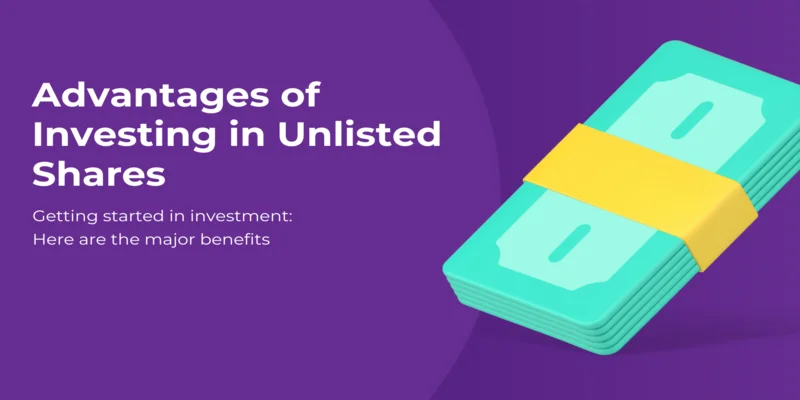Investing in publicly traded corporations like Reliance, TCS, Nestle, HDFC Bank, Larsen & Toubro, and many more is pretty common. But do you know you can also invest in unlisted businesses? It is the best way to grow your money over time as they are expanding swiftly and might offer exceptional profits.
Unlike those of listed companies, shares of unlisted firms cannot be traded on any stock market exchanges. So, people who wish to invest in these companies can do so through other venues.
Flipkart, Delhivery, Phonepe, and Ola are market leaders in terms of valuations, the number of services and items offered, or market reach. Many of them are growing much faster than the ones listed on the stock exchange.
The investment procedure of investing in unlisted companies is a little different but does not take much time to understand. All you need is an eye for detail when selecting these companies. Let’s delve in and uncover the mystery of investing in unlisted shares.
Difference Between Delisted Shares and Unlisted Shares
It is essential to know the difference between unlisted and delisted shares. Well, the fact is that these two share classes cannot be compared. Delisted shares are those that were once listed but were removed from the category of listed shares for various reasons. Unlisted shares are those that still need to be listed on stock exchanges.
On OTC marketplaces, you can trade and invest in unlisted shares but not in any delisted shares. Shares that have been delisted cannot be purchased on any platform, including OTC.
Companies may have unlisted shares if they do not intend to make an initial public offering (IPO) or satisfy SEBI’s criteria for listing the shares on any stock market (NSE or BSE).
On the other hand, firms have delisted shares when they don’t follow disclosure rules established by SEBI and stock exchanges. In this case, they are removed from stock exchanges. The other reason is when the company’s management wishes to remove the company from the stock market.
Ways to Become a Professional Investor
Here are a few ways in which you can become a diligent investor by investing in unlisted shares:
1. Pre-IPO investment
Before the company’s initial public offering (IPO), buying and selling company shares is referred to as pre-IPO trading. You cannot purchase these shares on the market like a stock exchange because they are prohibited from trade in the open market.
One can purchase unlisted shares through brokers and platforms that are experts in finding and placing unlisted shares and can help with the trade. Platforms and intermediaries buy shares from investors, both existing investors and novice investors, as well as from employees who have employee stock options (ESOP).
The pre-IPO market has expanded lately, and the best thing is that the general public can also access it. Some websites allow investors to purchase unlisted shares from companies, including Stockify, UnlistedZone, Analah Capital, Precize, TradeUnlisted, Unlistedkart and many more. Investors can keep the shares of these unlisted companies in a demat account.
As per the guidelines of India’s market regulator, all pre-IPO shares are restricted for six months following the listing date. It implies that you cannot sell equities before six months of the listing date.
If you sell the unlisted security within 24 months, it is categorized under short-term investments. The gains are included in the person’s income and taxed at the corresponding tax slab rate. Additionally, following indexation, it is taxed as long-term capital gains at 20% if sold after 24 months.
However, remember that unlisted shares are volatile and illiquid. Thus, you might not be able to trade your shares instantly. It is challenging to sell shares and obtain cash at any hour of the day because institutional players dominate the pre-IPO market, and their transactions are typically sluggish.
2. Pre-IPO funds
Investors invest in pre-IPO funds to get access to some of the best businesses quickly. Various wealth management companies invest in pre-IPO businesses such as Edelweiss Wealth Management, Kotak Investment Advisors, Trifecta Capital, and IIFL Wealth.
As per the reports, the Edelweiss Recently Listed IPO Fund has produced a compound annual growth rate (CAGR) of 21.7% since its inception. It has invested in around 100 recently listed companies and upcoming IPOs.
Because of the unpredictability and illiquidity of unlisted companies, it is recommended that a retail investor should only invest their extra funds in them. This means you should invest only additional money that you can afford to lose.
3. Private Placements
A real estate agent, money manager, or investment bank can help you determine the pricing and valuation of an unlisted company. This is an additional option. They might also be able to connect you with corporate promoters. You will then be able to buy only some of the shares they own. One option to purchase shares from the promoters is through private placements.
4. PMS and AIF funds
Investments in unlisted equities can also be made via portfolio management systems (PMS). These customized share portfolios can assist you with risk diversification by altering the weights of various assets within a portfolio in response to market sentiment.
Additionally, investors can target their capital toward unlisted shares by investing through Alternative Investment Funds (AIFs). Keep things simple in your mind, a preliminary investment of 1 crore is required for the AIF, compared to 50 lakhs for the PMS.
Advantages of Investing in Unlisted Shares

Everyone is aware of the benefits of investing in equity. But here are some advantages of investing in unlisted shares which you might not know:
- Higher Chances of Yielding Great Returns- Unlisted shares provide different risk dynamics and can benefit people with listed share investments. They can be a valuable tool for portfolio diversification. Comparing unlisted shares’ return potential to listed shares, the former is better. These equities could eventually go public, providing a significant gain when listed on stock exchanges. To invest in inexpensive stocks with high-profit growth potential, one should consider valuation criteria in addition to price, regardless of whether they are listed or unlisted shares.
- Low Valuation- Most unlisted shares are non-liquid; they can draw the attention of a group of investors who are prepared to hold onto their investments for a longer time. The valuations of these shares are usually low as there is less demand, and fewer people want to be a part of this group. There are numerous chances to buy an undervalued stock. However, recognizing these chances takes some skill and understanding. It might be preferable for a beginner to use the assistance of an expert who can give the necessary direction.
- Less Volatile- The shares are highly illiquid; therefore, there are fewer volatility concerns. The technical term for volatility is standard deviation, which is substantially lower than the volatility of listed shares. However, if the wrong investment is made, there might be a significant downside. Demand and supply for these stocks are not monitored daily; hence, the price does not change every day. This investment will experience less financial stress than public shares, thanks to the relative pricing stability.
Risk Factors for Investing in Unlisted Shares
Everything comes with its own risk factors and disadvantages. Here are the following risk factors you should acknowledge before investing in unlisted shares-
- Illiquid- Due to the large minimum investment amounts and absence of transacting parties, the shares cannot be bought or traded when you want them to. Thus, investments are made in shares that are infrequently traded.
- High Risk- As these businesses are not heavily regulated, they might intentionally engage in immoral actions. If any immortal activity is detected, you may lose all the invested assets. Investments in unlisted shares have an added risk of capital loss.
- No Dividend– Dividends are paid in regulated markets to shareholders who own shares of a corporation prior to the record date and on the ex-dividend date. Unlisted firms, however, surprisingly lack the approach of organized dividend delivery. Therefore, they may choose to forgo paying you any dividends.
- Uncertainty- If you own stock in an unlisted company with the expectation that it would rise in value once it becomes public, but the truth is that various unfortunate occurrences have caused the price to keep falling.
Taxation Norms on Unlisted Equity Shares

Earnings from an investment in unlisted company shares are subject to taxation in accordance with the rules for short-term capital gains if we sell it within 24 months. Profits made from unlisted shares can increase your income, therefore it will be taxed collectively based on your tax rate.
Long-Term Capital Gains: If shares of an unlisted company are sold during 24 24-month period after the purchase, the gains from the investment will be subject to a 20% tax after the indexation advantage. Under this, the acquisition price of shares is adjusted based on how much inflation impacts it.
If the price of unlisted shares drops below the Fair Market Value (FMV), a concept known to unlisted firms, the cost taken into account for taxation will differ from the share’s trading price. Therefore, an authorized investment bank will determine the Fair Market Value.
Conclusion
Many people think that investing in unlisted shares is risky, because of their exposure to high volatility, illiquidity, etc. But the fact is that knowing how to invest in unlisted shares can be highly lucrative when the company goes public at a higher valuation than the initial investment.
Investing in unlisted shares is very uncertain. There is no other way to hedge your positions than by engaging in specific derivatives contracts, which can once fall outside the purview of regulated markets. Therefore, it won’t be incorrect to characterize investments in unlisted shares as having two sides.
Vanshaj Sikri is a professional content writer, editor, and strategist for B2B SaaS, Digital Marketing, and Web3 domains. He specializes in crafting impactful blog posts to drive traffic, engagement and conversions.




1 Comment